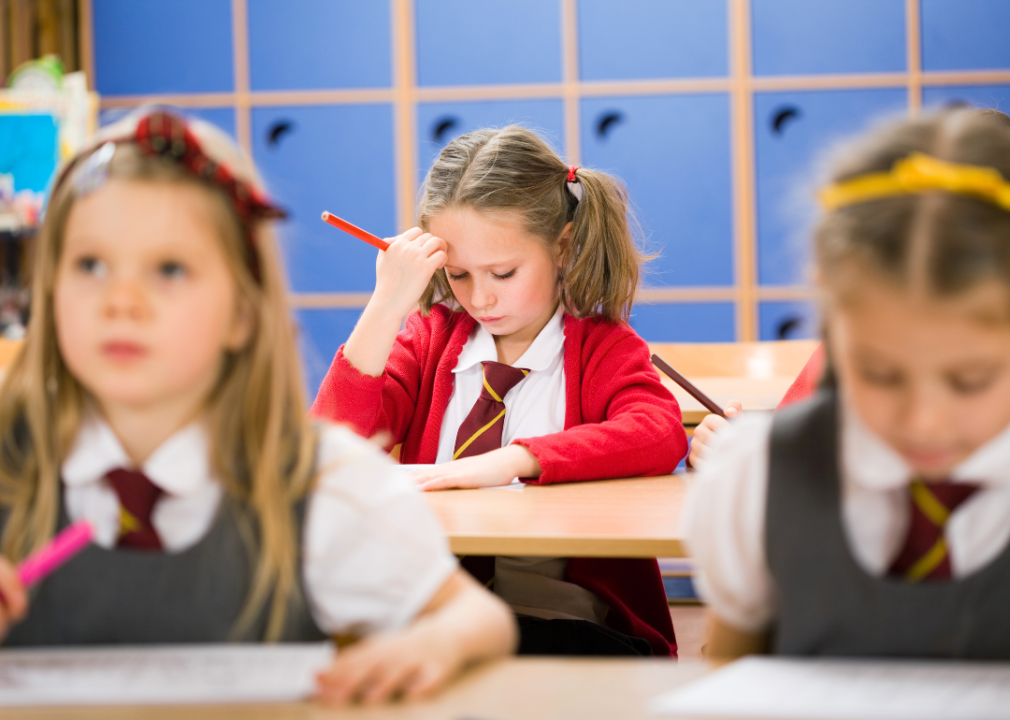Flags for mental health: How to spot signs of a struggling child

Ground Picture // Shutterstock
Flags for mental health: How to spot signs of a struggling child
Kids looking at phones in a classroom.
Is a struggling child just “going through a phase,” or is there something more serious going on?
Many families grapple with this question when trying to identify underlying mental health issues their child may be facing. Still, it is a complicated question. Throughout the stages of development—from toddlerhood to the preteen years and beyond—different challenges emerge, and each stage is defined by very different behaviors.
Not to mention that the 2020s have been a particularly stressful time to grow up.
Counseling Schools consulted experts on children and youth mental health and reviewed Centers for Disease Control and Prevention reports to get to know the telltale signs of a struggling child.
“Every generation of children faces challenges that shape their mental health and well-being,” Dave Daigle, associate director for communications at the CDC’s Global Health Center, told Stacker.
“While some positive stress is necessary for building appropriate coping mechanisms and forging a healthy sense of self-efficacy, other challenges may be overwhelming and lead to mental distress. This generation faces several such challenges,” added Daigle, who spoke to several CDC experts on family and childhood health and summarized their answers.
According to Daigle, there are three unique and difficult circumstances that affect today’s children and youth: the COVID-19 pandemic, the rise of social media, and events of mass violence. “The COVID-19 pandemic has been a significant disruption to every aspect of life across generations but has had a particular impact on the social, emotional, and academic health and development of young people,” Daigle said.
For younger children, COVID-19 may have amplified developmental struggles. Isolation, fewer social interactions with peers, and more screen time have all been linked to developmental delays, which were exacerbated during the pandemic. Excessive screen time in youth has also been shown to be detrimental to their mental and physical health, creating “habits” that are hard to break.
For tweens and teens, in particular, the predominance of social media, as well as the increased exposure to school gun violence, has led to poorer mental health outcomes. According to the National Institutes of Health, concerns about school shootings can cause higher instances of depression, anxiety, and generalized panic among adolescents. “Drills associated with being prepared for these events can also threaten a child’s sense of safety, even when no actual threat is present,” Daigle explained.
Higher rates of social media usage among teenagers correlate with low self-esteem and poor body image, according to the American Psychiatric Association. The risks are so prevalent that, in a guest essay for The New York Times, Surgeon General Vivek H. Murthy recommended adding warning labels on social media platforms. Murthy further suggested that the Surgeon General’s Advisory’s Social Media and Youth Mental Health report could serve as a resource for parents, policymakers, researchers, and technology companies to prevent potential risks.
Social and economic challenges can also contribute to mental distress in children and youth, Daigle added. Housing instability, food insecurity, and other economic barriers can be limiting factors. “This isn’t unique to this generation, per se, but it is still an important and ongoing contributor,” Daigle said.
Already vulnerable or frequently discriminated populations, including LGBTQ+ and Black youth, are at greater risk of experiencing feelings of distress, according to the CDC’s Division of Adolescent and School Health.
![]()

Canva
Warning signs, based on psychoanalyst Erik Erikson’s stages of psychosocial development
Female child looking down at her desk with frustrated expression as other girls remain attentive in classroom.
Early childhood (ages 3-6 years)
During early childhood, children exhibiting stress, confusion, or anger could be early indicators of mood disorders such as anxiety or depression, ADHD, or neurodivergence.
“Symptoms often start in early childhood, although some disorders may develop during the teenage years,” Daigle said, adding that serious changes in children’s behavior can cause distress and problems getting through the day.
Changes might include frequent or intense temper tantrums, fear or worry, being in constant motion, struggling to sit quietly, repeating certain actions out of fear that not doing so will cause a bad outcome (for instance, checking that a door is locked many times), or experiencing frequent physical pain or discomfort with no reasonable cause.
It is also important to note that what are considered warning signs will likely vary from culture to culture or even region to region. For instance, in some communities, crying loudly and often may be more acceptable; in others, it could be considered alarming, and thus indicate greater cause for concern about a child.
“Many children occasionally experience fears and worries or display disruptive behaviors,” Daigle said. “Early self-regulation—how we process thoughts into feelings and actions—helps us understand how children are developing.”
Middle childhood (ages 7-11 years)
During middle childhood, many of the same concerns from early childhood still apply, but with added considerations for the more complicated psychosocial developments among this age group. For instance, many gender-nonconforming children are around age 7 when they start to recognize that their gender identity is different than what they were assigned at birth. These children may experience anxiety at the realization that they are different from their peers.
Among all children, the onset of early puberty can also exacerbate or introduce issues rooted in depression, confusion, or the capacity to regulate intense emotions. “Youth with poor mental health may struggle with school and grades, decision making, and their health,” Daigle said. “Look for signs of disruption and changes in sleep, activity, friendships, and behavior.”
Additional signs could include discussing suicide or death, losing interest in socializing with friends, an inability to concentrate, feeling irritable, overly anxious, or excessively angry, and frequent nightmares.
Adolescence (ages 12-18 years)
It is no secret that adolescence is an emotionally and socially turbulent time. Many of the warning signs exhibited by a teenager struggling with their mental health can be less obvious and easier to conflate with the challenges that emerge during this time of transition and change.
According to Daigle, the same indicators from middle childhood also apply to adolescents, who may start exhibiting more behaviors that indicate that they are struggling.
“Mental health problems in youth often go hand-in-hand with other health and behavioral risks like increased risk of drug use, experiencing violence, and higher risk of sexual behaviors that can lead to HIV, STDs, and unintended pregnancy,” Daigle said. “Fortunately, the same prevention strategies that promote mental health—like helping students feel connected to school [or] family—help prevent a range of negative experiences, like drug use and violence.”
Daigle emphasized the importance of fostering relationships for adolescents, whether with family, friends, or members of the larger community. These bonds are critical in establishing a sense of connectedness, which can act as a crucial deterrent for negative mental health outcomes. “Youth need to know someone cares about them,” Daigle said.
These indicators are universally applicable; every child, family, community, and culture is different. Additionally, these flags should not be taken as direct medical advice but rather help caretakers and parents identify whether they should seek professional assessment.
“Just like with physical illness, treating mental health problems early may help to prevent a more serious illness from developing in the future,” Daigle said. “Talk to your child’s health care professional if you have concerns about the way your child behaves at home, in school, or with friends. Continue to have open and honest discussions with your child, offering encouragement and support.”
Story editing by Alizah Salario. Additional editing by Kelly Glass. Copy editing by Sofía Jarrín. Photo selection by Lacy Kerrick.
This story originally appeared on Counseling Schools and was produced and
distributed in partnership with Stacker Studio.